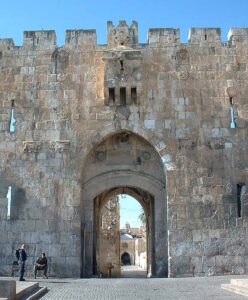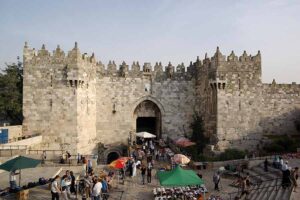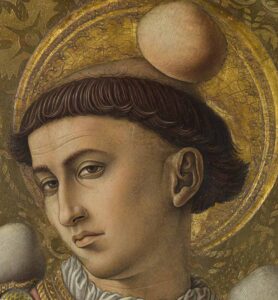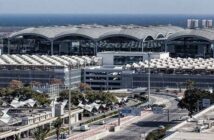
Deacon Stephen, the first martyred saint, is associated with December 26 since 415AD. As described in the Acts of the Apostles, St. Stephen was a deacon in the early Church in Jerusalem those teachings caused discontent among members of different synagogues and led to accusations of blasphemy. During his trial, Stephen spoke out against the Jewish authorities who were judging him. Consequently, he was stoned to death. Saul of Tarsus, who would later be known as the apostle Paul, was present and participated in Stephen’s martyrdom. Another St Stephen (975-1038) was first king of Hungary.

- St. Stephen’s Greek Orthodox Church (Jerusalem): Located outside the eastern gate of Jerusalem, believed to be the site of St. Stephen’s martyrdom.
- San Lorenzo fuori le Mura (Rome): Pope Pelagius II brought the relics of St. Stephen to Rome during the construction of this basilica and placed them alongside the relics of St. Lawrence.
- St. Stephen’s Green (Dublin): St. Stephen’s Green, opened as public park in 1880, is a famous escape from the crowded city centre with its ponds, leafy trails, bridges and statues. The designation comes from the nearby site of a 1230 leper colony named for St Stephen, predecessor of Mercer’s Hospital on Stephen Street. The Shopping Centre Shopping Centre is a popular retail destination in Dublin.

- Imperial Regalia of the Holy Roman Empire (Vienna): The collection in the Hofburg palace includes St. Stephen’s Purse, an elaborate reliquary believed to contain soil soaked with the blood of St. Stephen.
- St. Stephen’s Gate (eastern Jerusalem): St. Stephen’s Gate, also known as Lion’s Gate, is one of the entrances to the Old City of Jerusalem.
- St. Stephen’s Gate (north Jerusalem): Initially named after the proximity to the martyrdom site and the church built by Empress Eudocia, the Crusaders later transferred the name to the more accessible eastern gate of Jerusalem.

- Beit Jimal (Israel): The Salesian monastery of Beit Jimal 30km from Jerusalem is held to be the place where his remains were miraculously found, according to a dream experienced by the priest Lucian.
- Hagia Sion (Jerusalem): The relics of St. Stephen were taken to this church on December 26, 415, which became the feast day of St. Stephen.
- Saint-Étienne Basilica (Jerusalem): A 20th-century representation of a church constructed north of the Damascus Gate by empress Aelia Eudocia honour of St. Stephen and housed his relics, destroyed in the 12th century.

- Trinity Lavra of St. Sergius (Sergiyev Posad, Russia): This Russian monastery 70km northeast of Moscow encloses part of the right arm of St. Stephen.
- Santo Stefano Rotondo (Rome): Commissioned by Constantine I, this church in Rome was built on the ruins of the Caelian Hill. It is the first circular-shaped church in Rome, deviating from the traditional cross designs.
- San Lorenzo fuori le Mura (Rome): Saint Stephen is believed to be interred in the crypt of this church in Rome, together with Saint Lawrence, beneath the high altar.
- Santo Stefano degli Abissini (Vatican City): This Coptic Christian church in Vatican City is also the National Church of Ethiopia in Rome.
- Basilica Papale di San Paolo fuori le Mura (Rome): A side chapel dedicated to St. Stephen is located near the tomb of St. Paul in this basilica in Rome.
- Santo Stefano Maggiore (Milan): This baroque church in Milan, originally dedicated to both St. Stephen and St. Zecheriah, was built in the 5th century.
- Saint Stephen Church of Lmbat (Armenia): This 7th-century church is situated near the town of Artik in Armenia.
- Saint Stephen Armenian Monastery (Iran): Located near Jolfa in northwestern Iran, this 9th-century monastery is associated with St. Stephen and the Armenian Apostolic Church.
- St. Stepanos Armenian Church (Izmir, Turkey): Constructed in 1863, this church in Izmir, Turkey, dedicated to St. Stephen, was unfortunately destroyed during the Catastrophe of Smyrna in September 1922.
- Saint-Étienne Basilica and Cathedral (Paris), on the Île de la Cité, was an early Christian church that preceded Notre-Dame de Paris. It was built in the 4th or 5th century, directly in front of the location of the modern cathedral, 250 metres from the royal palace.
- St. Stephen’s Gate (Dubrovnik): The St. Stephen’s Gate, also known as Buža Gate, is one of the principal entrances to Dubrovnik’s famous city walls. It leads to hidden cliffs overlooking the Adriatic Sea.
- St. Stephen’s Cathedral (Vienna): Also known as Stephansdom, this Gothic masterpiece stands in Vienna’s center. Its intricate architecture and soaring spires make it a significant symbol of the city.
- St. Stephen’s Cathedral (Passau, Germany): Situated at the confluence of the Danube, Inn, and Ilz rivers, St. Stephen’s Cathedral is a Baroque masterpiece in Passau. It boasts an awe-inspiring interior and houses the largest cathedral organ in the world.
- St. Stephen’s Chapel (Vianden, Luxembourg): Found in the picturesque town of Vianden, this chapel is dedicated to St. Stephen. It features beautiful medieval architecture and offers a glimpse into the region’s history.
- St. Stephen’s Church (Melbourne): Located in Melbourne, this historic Anglican church is known for its architecture and intricate stained glass windows. It serves as a venue for various cultural events.

- St. Stephen’s Church (Stockholm): This medieval church is situated in Stockholm’s Gamla Stan (Old Town). It showcases stunning medieval architecture, sculptures, and frescoes.
- St. Stephen’s House (Oxford, England): St. Stephen’s House is an Anglican theological college and a Permanent Private Hall of the University of Oxford. This historic institution offers theological education and serves as a religious community for its students.
- St. Stephen’s Tower (Bristol): St. Stephen’s Tower is part of the historic Bristol City Hall. It stands tall with its clock and bell tower that adds charm to the city’s skyline. The tower offers fantastic views of Bristol and its surroundings.
- St. Stephen’s Beach (Hong Kong, China): St. Stephen’s Beach is a picturesque sandy beach located on the southwestern part of Hong Kong Island. It offers a serene setting for sunbathing, beach activities, and picnics, all while enjoying the beautiful views of the South China Sea.



